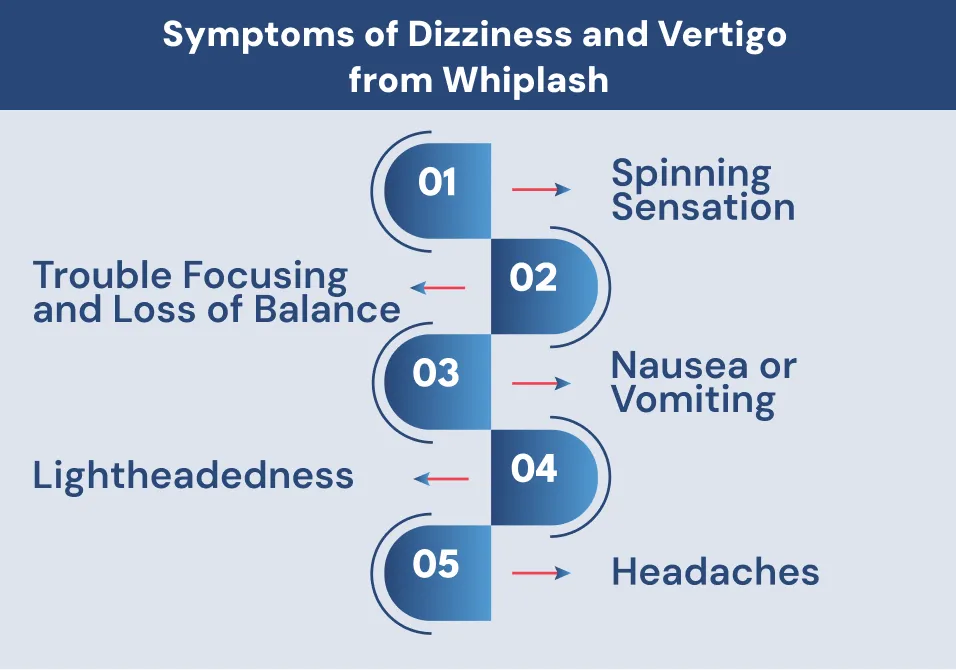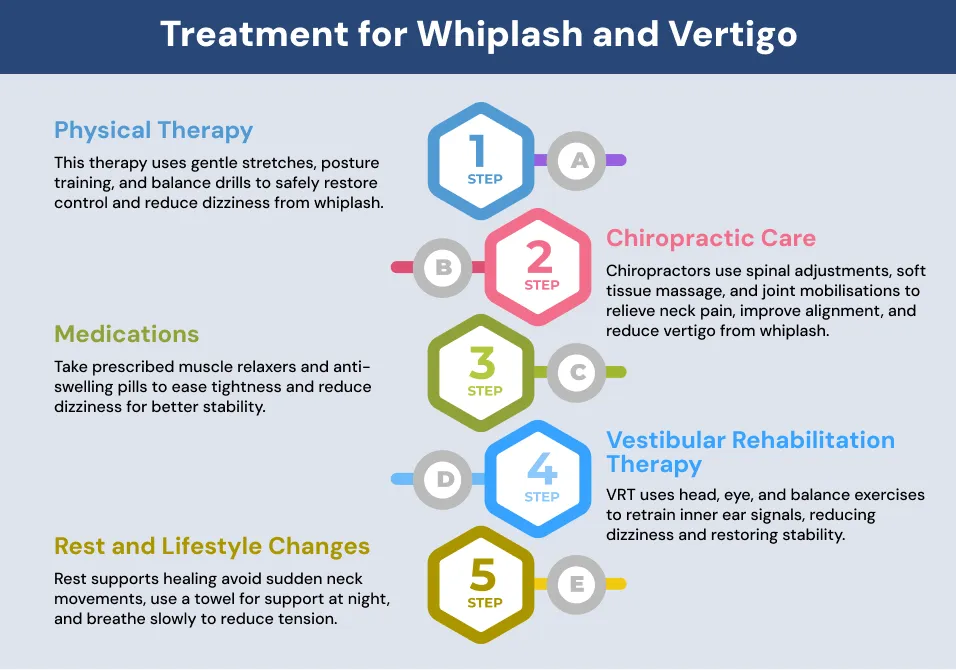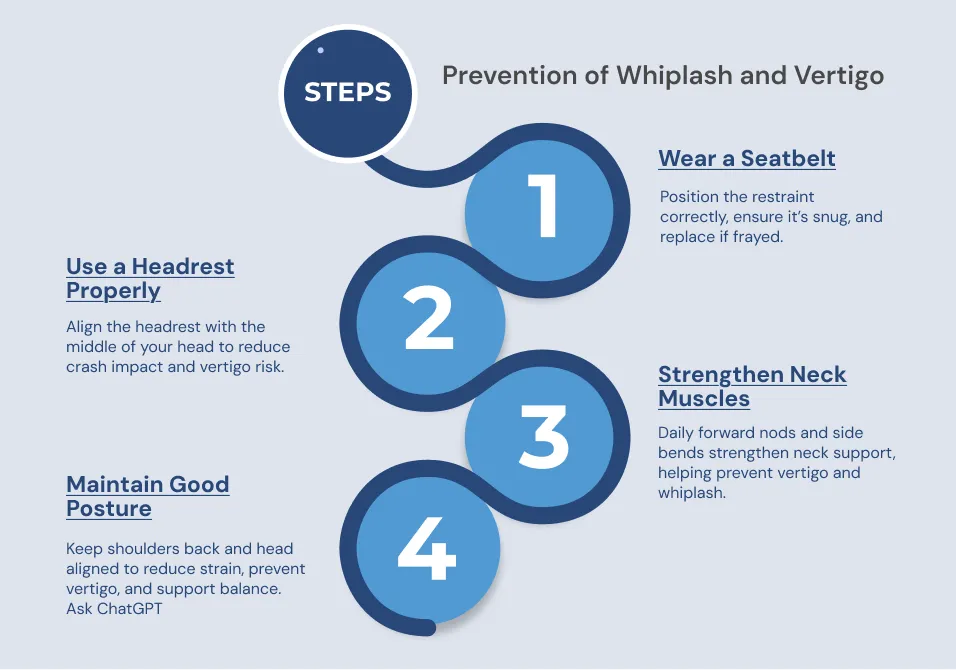TABLE OF CONTENT
Yes, whiplash can cause vertigo. Basically, whiplash is a neck injury from a sudden hit, often in car crashes. The head jerks back and forth quickly. People know whiplash for neck pain, but it can also lead to vertigo and whiplash dizziness.
According to ABI, people file more than 1,500 whiplash claims every day in the UK. Because so many accidents cause whiplash, it ranks among the top injuries about which people claim for. Many who claim say they struggle with feeling lightheaded and having poor stability. Research finds that a bad neck injury and bouts of vertigo can disrupt daily tasks and lessen enjoyment of life.
After a crash, whiplash can upset both your upper spine and your inner ear. These parts help you stay balanced. Disturbance of this balance may lead to shaky, woozy, or off kilter. Noticing these signs early lets you get help before the problem worsens.
The Link Between Whiplash and Dizziness
Many people believe that Whiplash is just a neck injury that might impact body balance. But it is more than that, as it also affects the coordination between different parts of the body. A sudden head movement in an accident can strain muscles, hurt nerves, and cut blood flow. This disturbs the vestibular system which controls balance and can cause vertigo. Vertigo is the feeling of spinning or dizziness. Evidence indicates a connection between cervical neck pain and vertigo because issues in the upper cervical spine, where nerves and blood vessels meet the head, can disrupt inner ear function and trigger dizziness.
Symptoms of Dizziness and Vertigo from Whiplash
Whiplash-related vertigo can make you feel like the room is spinning or that you’re tipping over. Let’s go through the most important symptoms that show whiplash can cause vertigo:
1. Spinning Sensation
After a neck impact, you might feel the entire room is turning even if you stay still. This spinning happens because Whiplash can cause vertigo by disrupting inner ear signals. Episodes can last seconds or minutes and make walking or sitting very hard.
2. Trouble Focusing and Loss of Balance
Blurred vision or difficulty concentrating can follow a dizzy spell. Due to vertigo, your body loses cues from the inner ear and neck joints. Whiplash can cause vertigo by creating a spinning sensation that makes you feel off balance and distracts you, leaving your mind feeling foggy. Reading or screen work becomes challenging until signals from the inner ear stabilise.

3. Nausea or Vomiting
When your head spins, it can send mixed signals to your stomach. This often makes you feel sick or even vomit. When the spinning stops, the sick feeling usually goes away. During that phase you might not feel like eating and could get thirsty.
4. Lightheadedness
You may feel faint or shaky, as if you could tip over. Whiplash can cause vertigo by slowing down blood flow when you twist your neck too fast. It’s best to sit down and wait for the faint feeling to pass.
5. Headaches
A dull ache or a tight pain at the back of your head can follow a neck jolt. Whiplash can cause vertigo by irritating neck nerves, which adds to head pressure. Applying a cold pack or doing a gentle neck rub can ease the ache until you see a doctor.
These signs often worsen when you stand up quickly or look over your shoulder. Daily chores can feel tough when your head spins.
Main Causes of Vertigo Due to Whiplash
Whiplash often results in vertigo. There are two main reasons why whiplash can cause it?
- Nerve damage
The cervical spine has nerves that help with balance. When injured, it sends wrong signals to the brain, leading to dizziness. - Inner ear dysfunction
The vestibular system in your inner ear controls the balance of your body. Whiplash can cause vertigo by messing with this system, leading to whiplash dizziness.
As research published in National Institutes of Health,
“Whiplash injury is not only limited to neck injury but also brainstem injury that does not involve direct damage to the neck or head. The symptoms of whiplash injury are polymorphous, with the most common complaints being cervical pain, headache and scapulodynia. Vertigo and dizziness are also reported in 25–50% of the cases”
(Endo et al)
Diagnosing Whiplash-Induced Vertigo
Diagnosis starts with a review of the injury and any whiplash dizziness. The doctor performs balance and inner ear tests. The exam covers whiplash and vertigo. It also checks for dizziness from whiplash and cervical dizziness. The test evaluates can whiplash cause dizziness and can neck problems cause dizziness. Imaging such as X-ray or MRI reveals cervical neck pain and vertigo or nerve injury. Early diagnosis prevents minor strains from becoming long-term headaches.
Treatment for Whiplash and Vertigo
Managing dizziness after injury takes several steps. Physical therapy, manual care and medication all help. These treatments build neck strength. They also retrain balance pathways. Since whiplash can cause vertigo, combining exercises with medical support speeds relief. Below are a few ways to manage whiplash dizziness and improve quality of life.
1. Physical Therapy
This therapy uses gentle neck stretches. Strengthening exercises follow. Therapists teach correct posture and head alignment. Balance drills such as standing on one foot retrain the inner ear. These moves rebuild muscle control. They also reduce dizziness from whiplash. Progress is slow and steady to keep treatment safe.
2. Chiropractic Care
Chiropractors use precise spinal adjustments. These restore neck alignment. They also ease nerve pressure and help with cervical neck pain and vertigo. Gentle mobilisations improve joint function and reduce pain. Adjustments alter balance signals from the neck and inner ear. Regular sessions often lessen whiplash dizziness and speed ongoing healing. Two common techniques are soft tissue massage and targeted joint mobilisations.

The Epley Maneuver
The doctor gently moves your head through different positions to shift tiny crystals in the inner ear. This technique can stop the spinning and nausea of vertigo in minutes. Many patients feel much better without taking medicine, as it brings back balance fast and safely.
Spinal Realignments
Accidents can knock neck joints out of place. Gentle adjustment sessions guide them back, easing pain and swelling. Once your joints sit correctly, nerves send clear balance signals and vertigo often eases without heavy drugs.
Read: Chiropractic Care for Whiplash
3. Medications
Take muscle relaxers and anti‑swelling pills as your doctor tells you to calm tight muscles. They also help ease dizziness so you feel steadier.
4. Vestibular Rehabilitation Therapy (VRT)
VRT uses targeted head and eye exercises to retrain balance pathways. Repeating slow head turns and tracking moving targets reprograms inner ear signals. Balance drills, like tandem walking, strengthen stability. VRT can significantly reduce spinning sensations and help you move with confidence again.
5. Rest and Lifestyle Changes
Rest helps the injured tissue recover faster. Rest your neck by avoiding quick turns and heavy lifting. At night, tuck a small rolled towel under your neck and breathe slowly to ease tension.
Read more about Whiplash Treatment.
Prevention of Whiplash and Vertigo
Following steps help keep your neck stable and cut the chance that whiplash will lead to vertigo or dizziness.
- Wear a Seatbelt
Secure the restraint so its slanted section crosses your mid‑torso and the lower band lies snug across your pelvis. A firm hold prevents jolts from sending your head backward. Inspect it often and replace any frayed material.
- Use a Headrest Properly
Position your headrest so its top aligns with the middle of your head. This support reduces backward motion in a crash and lowers the chance that vertigo.
- Strengthen Neck Muscles
Forward head nods paired with lateral flexes, repeated daily, fortify support around the cervical base. Boosted muscle tone buffers against quick motions and preserves equilibrium. Whiplash can cause vertigo if those fibers lack endurance.
- Maintain Good Posture
Keep shoulders back and head straight over your spine. Good posture eases strain and reduces causes of vertigo. Maintaining this alignment throughout the day supports neck health and balance.

Case of Vertigo After Whiplash Trauma
An old man felt dizziness hours after a rear‑end collision. His whiplash led to vertigo and balance issues. Inner ear tests showed weakness. He did motion exercises and took anti‑vertigo medication. Within weeks his balance returned. He also attended follow‑up sessions to track his recovery and prevent any setbacks.
Long-Term Outlook
Because Whiplash can cause vertigo, recovery times differ. Many see improvement in a few weeks. Others need months of care. Do your exercises every day and go to your doctor or therapist visits. This will help your dizziness get better. Write down how you feel each day. Note any good or bad changes. Celebrate little progress. These little successes will cheer your healing journey.
The Importance of Early Treatment
If you notice any dizziness after a neck injury, see a doctor right away. Early check‑ups can find if whiplash can cause vertigo. Starting care fast usually means less pain and a quicker return to normal. Ignoring mild dizziness can lead to bigger balance problems later.
If you are still confused about it, whiplash can cause vertigo? or dealing with dizziness from whiplash or other vertigo symptoms, reach out to us today.
Concise Medico offers expert diagnosis and custom treatment plans.
FAQs
Yes, whiplash can cause vertigo. Basically, whiplash is a neck injury from a sudden hit, often in car crashes. The head jerks back and forth quickly. People know whiplash for neck pain, but it can also lead to vertigo and whiplash dizziness.
According to ABI, people file more than 1,500 whiplash claims every day in the UK. Because so many accidents cause whiplash, it ranks among the top injuries about which people claim for. Many who claim say they struggle with feeling lightheaded and having poor stability. Research finds that a bad neck injury and bouts of vertigo can disrupt daily tasks and lessen enjoyment of life.
After a crash, whiplash can upset both your upper spine and your inner ear. These parts help you stay balanced. Disturbance of this balance may lead to shaky, woozy, or off kilter. Noticing these signs early lets you get help before the problem worsens.
The Link Between Whiplash and Dizziness
Many people believe that Whiplash is just a neck injury that might impact body balance. But it is more than that, as it also affects the coordination between different parts of the body. A sudden head movement in an accident can strain muscles, hurt nerves, and cut blood flow. This disturbs the vestibular system which controls balance and can cause vertigo. Vertigo is the feeling of spinning or dizziness. Evidence indicates a connection between cervical neck pain and vertigo because issues in the upper cervical spine, where nerves and blood vessels meet the head, can disrupt inner ear function and trigger dizziness.
Symptoms of Dizziness and Vertigo from Whiplash
Whiplash-related vertigo can make you feel like the room is spinning or that you’re tipping over. Let’s go through the most important symptoms that show whiplash can cause vertigo:
1. Spinning Sensation
After a neck impact, you might feel the entire room is turning even if you stay still. This spinning happens because Whiplash can cause vertigo by disrupting inner ear signals. Episodes can last seconds or minutes and make walking or sitting very hard.
2. Trouble Focusing and Loss of Balance
Blurred vision or difficulty concentrating can follow a dizzy spell. Due to vertigo, your body loses cues from the inner ear and neck joints. Whiplash can cause vertigo by creating a spinning sensation that makes you feel off balance and distracts you, leaving your mind feeling foggy. Reading or screen work becomes challenging until signals from the inner ear stabilise.

3. Nausea or Vomiting
When your head spins, it can send mixed signals to your stomach. This often makes you feel sick or even vomit. When the spinning stops, the sick feeling usually goes away. During that phase you might not feel like eating and could get thirsty.
4. Lightheadedness
You may feel faint or shaky, as if you could tip over. Whiplash can cause vertigo by slowing down blood flow when you twist your neck too fast. It’s best to sit down and wait for the faint feeling to pass.
5. Headaches
A dull ache or a tight pain at the back of your head can follow a neck jolt. Whiplash can cause vertigo by irritating neck nerves, which adds to head pressure. Applying a cold pack or doing a gentle neck rub can ease the ache until you see a doctor.
These signs often worsen when you stand up quickly or look over your shoulder. Daily chores can feel tough when your head spins.
Main Causes of Vertigo Due to Whiplash
Whiplash often results in vertigo. There are two main reasons why whiplash can cause it?
- Nerve damage
The cervical spine has nerves that help with balance. When injured, it sends wrong signals to the brain, leading to dizziness. - Inner ear dysfunction
The vestibular system in your inner ear controls the balance of your body. Whiplash can cause vertigo by messing with this system, leading to whiplash dizziness.
As research published in National Institutes of Health,
“Whiplash injury is not only limited to neck injury but also brainstem injury that does not involve direct damage to the neck or head. The symptoms of whiplash injury are polymorphous, with the most common complaints being cervical pain, headache and scapulodynia. Vertigo and dizziness are also reported in 25–50% of the cases”
(Endo et al)
Diagnosing Whiplash-Induced Vertigo
Diagnosis starts with a review of the injury and any whiplash dizziness. The doctor performs balance and inner ear tests. The exam covers whiplash and vertigo. It also checks for dizziness from whiplash and cervical dizziness. The test evaluates can whiplash cause dizziness and can neck problems cause dizziness. Imaging such as X-ray or MRI reveals cervical neck pain and vertigo or nerve injury. Early diagnosis prevents minor strains from becoming long-term headaches.
Treatment for Whiplash and Vertigo
Managing dizziness after injury takes several steps. Physical therapy, manual care and medication all help. These treatments build neck strength. They also retrain balance pathways. Since whiplash can cause vertigo, combining exercises with medical support speeds relief. Below are a few ways to manage whiplash dizziness and improve quality of life.
1. Physical Therapy
This therapy uses gentle neck stretches. Strengthening exercises follow. Therapists teach correct posture and head alignment. Balance drills such as standing on one foot retrain the inner ear. These moves rebuild muscle control. They also reduce dizziness from whiplash. Progress is slow and steady to keep treatment safe.
2. Chiropractic Care
Chiropractors use precise spinal adjustments. These restore neck alignment. They also ease nerve pressure and help with cervical neck pain and vertigo. Gentle mobilisations improve joint function and reduce pain. Adjustments alter balance signals from the neck and inner ear. Regular sessions often lessen whiplash dizziness and speed ongoing healing. Two common techniques are soft tissue massage and targeted joint mobilisations.

The Epley Maneuver
The doctor gently moves your head through different positions to shift tiny crystals in the inner ear. This technique can stop the spinning and nausea of vertigo in minutes. Many patients feel much better without taking medicine, as it brings back balance fast and safely.
Spinal Realignments
Accidents can knock neck joints out of place. Gentle adjustment sessions guide them back, easing pain and swelling. Once your joints sit correctly, nerves send clear balance signals and vertigo often eases without heavy drugs.
Read: Chiropractic Care for Whiplash
3. Medications
Take muscle relaxers and anti‑swelling pills as your doctor tells you to calm tight muscles. They also help ease dizziness so you feel steadier.
4. Vestibular Rehabilitation Therapy (VRT)
VRT uses targeted head and eye exercises to retrain balance pathways. Repeating slow head turns and tracking moving targets reprograms inner ear signals. Balance drills, like tandem walking, strengthen stability. VRT can significantly reduce spinning sensations and help you move with confidence again.
5. Rest and Lifestyle Changes
Rest helps the injured tissue recover faster. Rest your neck by avoiding quick turns and heavy lifting. At night, tuck a small rolled towel under your neck and breathe slowly to ease tension.
Read more about Whiplash Treatment.
Prevention of Whiplash and Vertigo
Following steps help keep your neck stable and cut the chance that whiplash will lead to vertigo or dizziness.
- Wear a Seatbelt
Secure the restraint so its slanted section crosses your mid‑torso and the lower band lies snug across your pelvis. A firm hold prevents jolts from sending your head backward. Inspect it often and replace any frayed material.
- Use a Headrest Properly
Position your headrest so its top aligns with the middle of your head. This support reduces backward motion in a crash and lowers the chance that vertigo.
- Strengthen Neck Muscles
Forward head nods paired with lateral flexes, repeated daily, fortify support around the cervical base. Boosted muscle tone buffers against quick motions and preserves equilibrium. Whiplash can cause vertigo if those fibers lack endurance.
- Maintain Good Posture
Keep shoulders back and head straight over your spine. Good posture eases strain and reduces causes of vertigo. Maintaining this alignment throughout the day supports neck health and balance.

Case of Vertigo After Whiplash Trauma
An old man felt dizziness hours after a rear‑end collision. His whiplash led to vertigo and balance issues. Inner ear tests showed weakness. He did motion exercises and took anti‑vertigo medication. Within weeks his balance returned. He also attended follow‑up sessions to track his recovery and prevent any setbacks.
Long-Term Outlook
Because Whiplash can cause vertigo, recovery times differ. Many see improvement in a few weeks. Others need months of care. Do your exercises every day and go to your doctor or therapist visits. This will help your dizziness get better. Write down how you feel each day. Note any good or bad changes. Celebrate little progress. These little successes will cheer your healing journey.
The Importance of Early Treatment
If you notice any dizziness after a neck injury, see a doctor right away. Early check‑ups can find if whiplash can cause vertigo. Starting care fast usually means less pain and a quicker return to normal. Ignoring mild dizziness can lead to bigger balance problems later.
If you are still confused about it, whiplash can cause vertigo? or dealing with dizziness from whiplash or other vertigo symptoms, reach out to us today.
Concise Medico offers expert diagnosis and custom treatment plans.



